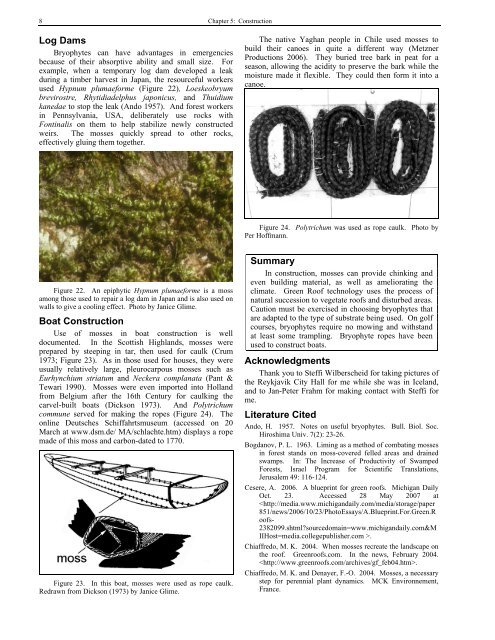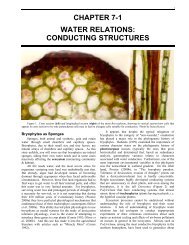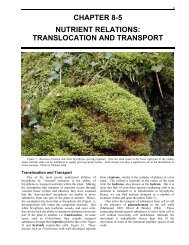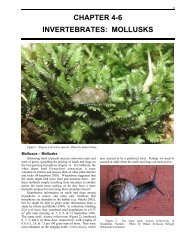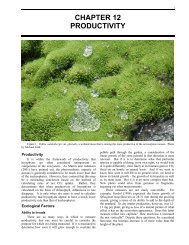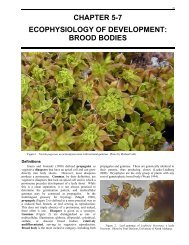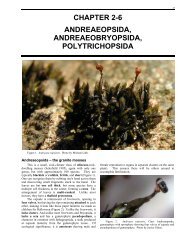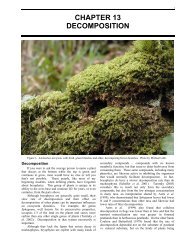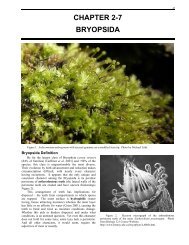Chapter 5: Construction - Bryophyte Ecology
Chapter 5: Construction - Bryophyte Ecology
Chapter 5: Construction - Bryophyte Ecology
Create successful ePaper yourself
Turn your PDF publications into a flip-book with our unique Google optimized e-Paper software.
8<br />
Log Dams<br />
<strong>Bryophyte</strong>s can have advantages in emergencies<br />
because of their absorptive ability and small size. For<br />
example, when a temporary log dam developed a leak<br />
during a timber harvest in Japan, the resourceful workers<br />
used Hypnum plumaeforme (Figure 22), Loeskeobryum<br />
brevirostre, Rhytidiadelphus japonicus, and Thuidium<br />
kanedae to stop the leak (Ando 1957). And forest workers<br />
in Pennsylvania, USA, deliberately use rocks with<br />
Fontinalis on them to help stabilize newly constructed<br />
weirs. The mosses quickly spread to other rocks,<br />
effectively gluing them together.<br />
Figure 22. An epiphytic Hypnum plumaeforme is a moss<br />
among those used to repair a log dam in Japan and is also used on<br />
walls to give a cooling effect. Photo by Janice Glime.<br />
Boat <strong>Construction</strong><br />
Use of mosses in boat construction is well<br />
documented. In the Scottish Highlands, mosses were<br />
prepared by steeping in tar, then used for caulk (Crum<br />
1973; Figure 23). As in those used for houses, they were<br />
usually relatively large, pleurocarpous mosses such as<br />
Eurhynchium striatum and Neckera complanata (Pant &<br />
Tewari 1990). Mosses were even imported into Holland<br />
from Belgium after the 16th Century for caulking the<br />
carvel-built boats (Dickson 1973). And Polytrichum<br />
commune served for making the ropes (Figure 24). The<br />
online Deutsches Schiffahrtsmuseum (accessed on 20<br />
March at www.dsm.de/ MA/schlachte.htm) displays a rope<br />
made<br />
of this moss and carbon-dated to 1770.<br />
Figure 23. In this boat, mosses were used as rope caulk.<br />
Redrawn from Dickson (1973) by Janice Glime.<br />
<strong>Chapter</strong> 5: <strong>Construction</strong><br />
The native Yaghan people in Chile used mosses to<br />
build their canoes in quite a different way (Metzner<br />
Productions 2006). They buried tree bark in peat for a<br />
season, allowing the acidity to preserve the bark while the<br />
moisture made it flexible. They could then form it into a<br />
canoe.<br />
Figure 24. Polytrichum was used as rope caulk. Photo by<br />
Per Hoffmann.<br />
Summary<br />
In construction, mosses can provide chinking and<br />
even building material, as well as ameliorating the<br />
climate. Green Roof technology uses the process of<br />
natural succession to vegetate roofs and disturbed areas.<br />
Caution must be exercised in choosing bryophytes that<br />
are adapted to the type of substrate being used. On golf<br />
courses, bryophytes require no mowing and withstand<br />
at least some trampling. <strong>Bryophyte</strong> ropes have been<br />
used to construct boats.<br />
Acknowledgments<br />
Thank you to Steffi Wilberscheid for taking pictures of<br />
the Reykjavik City Hall for me while she was in Iceland,<br />
and to Jan-Peter Frahm for making contact with Steffi for<br />
me.<br />
Literature Cited<br />
Ando, H. 1957. Notes on useful bryophytes. Bull. Biol. Soc.<br />
Hiroshima Univ. 7(2): 23-26.<br />
Bogdanov, P. L. 1963. Liming as a method of combating mosses<br />
in forest stands on moss-covered felled areas and drained<br />
swamps. In: The Increase of Productivity of Swamped<br />
Forests, Israel Program for Scientific Translations,<br />
Jerusalem 49: 116-124.<br />
Cesere, A. 2006. A blueprint for green roofs. Michigan Daily<br />
Oct. 23. Accessed 28 May 2007 at<br />
.<br />
Chiaffredo, M. K. 2004. When mosses recreate the landscape on<br />
the roof. Greenroofs.com. In the news, February 2004.<br />
.<br />
Chiaffredo, M. K. and Denayer, F.-O. 2004. Mosses, a necessary<br />
step for perennial plant dynamics. MCK Environnement,<br />
France.


